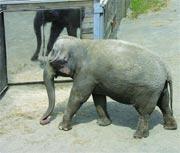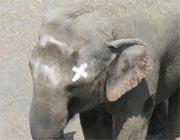 Who's that? Elephants can recognize it's not a stranger in the mirror.
Who's that? Elephants can recognize it's not a stranger in the mirror.Elephants possess the highly cerebral ability to recognize their own jumbo reflections in mirrors, scientists have found.
Traditionally, only an elite group of animals including humans, chimpanzees and orangutans have been proved to be capable of self-recognition in a mirror. A lone study several years ago also reported that dolphins could recognize their own gaze in a glass1.
Researchers have suspected that elephants might possess the capacity for self-recognition and self-awareness because of their highly developed social behaviour. A study reported this week in the Proceedings of the National Academy of Science documents the evidence for three clever elephants2.
"All three showed self-directed behavior in front of the mirror, and thus we were convinced that all three recognized that the mirror image was themselves," says Joshua Plotnik, a doctoral student from Emory University in Atlanta, Georgia, and the lead author on the paper.
Mirror, mirror on the wall
To study the elephants' behavior, the researchers placed an "elephant-proof, jumbo-sized" mirror, 2.5 metres high by 2.5 metres wide, inside the enclosure of three female Asian elephants (Elephas maximus) at the Bronx Zoo in New York City. The team used a still camera on a roof to observe the animals over a period of five months.
Upon entering the yard, all three elephants ran to inspect the mirror. The elephants, named Happy, Maxine and Patty, immediately investigated the surface by sniffing and touching it with their trunks — even attempting to climb the mirror to look behind it and kneeling down to look under it.
They didn't display threatening behaviour such as trumpeting, which might have been expected if they saw the images as intruder elephants.
Later, the animals used the mirrors to inspect their own bodies — peering inside their mouths, for example. At one point, Maxine used her trunk to pull her ear close to the mirror for inspection.
Me, me, me
 When a white mark was placed on Happy's face, she knew to investigate herself rather than her reflection.
When a white mark was placed on Happy's face, she knew to investigate herself rather than her reflection.The concept of mirror self-recognition (MSR) is defined by animal behaviour specialists by four stages: making a social response to a reflection; examining the mirror itself; repetitive behaviour around the mirror; and self-directed behaviour.
The elephants' behaviour showed all four stages, although only Happy passed a definitive test of the fourth phase, called the 'mark test'. A white cross was surreptitiously placed on Happy's face without her noticing. When she then looked in the mirror, her response was to touch the mark on her own face, rather than reaching out to inspect the mark in the reflection.
Such behaviour is considered to be a fundamental part of the development of a sense of self and a theory of mind. Human babies do not recognize a mirror reflection as being themselves, but typically learn this by the age of two.
Self-recognition is also strongly linked to empathy; it is thought that an animal needs to be able to understand itself in this way before it can empathize with others. Children too need to develop this skill over time.
Plotnik and colleagues think that few other animals will be found to possess the capacity for full self-recognition. If more are discovered, Plotnik says, it will probably be in a highly intelligent mammal, such as the killer whale.
Visit our notfooledbymirror.html">newsblog to read and post comments about this story.
-
References
- Reiss D.& Marino L. . Proc Natl Acad Sci, 98 . 5937 - 5942 (2001).
- Plotnik J. M., et al. Proc Natl Acad Sci, 103 . 17053 - 17057 (2006). www.pnas.org_cgi_doi_10.1073_pnas.0608062103
